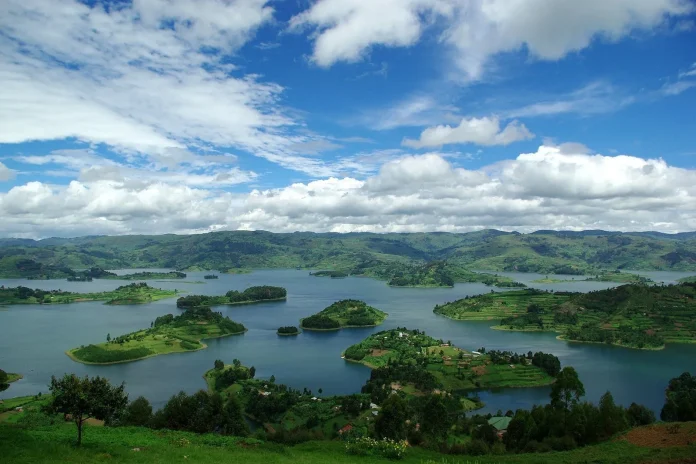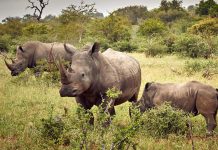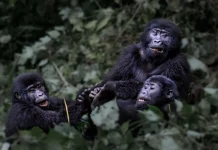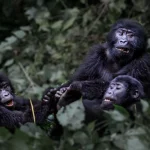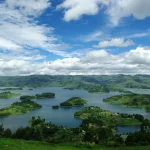Lake Bunyonyi is a lava-dammed freshwater lake located in Kabale and Rubanda districts of the Kigezi sub-region, southwestern Uganda a region also known as the Gorilla Highlands. The lake was formed around 18,000 years ago when lava from the Virunga volcanic mountains blocked the course of the Ndego River, leading to water accumulation in the valleys between the region’s steep-sided hills. As a result of this geologic activity, a narrow, deep lake was formed with depths ranging from 44 to 900 meters, making for the second deepest lake in Africa. Lake Tanganyika in Tanzania, which has a maximum depth of 1,471 meters is Africa’s deepest lake. Lake Bunyonyi spans 60 Sq. km, and its sub-catchment area Ruhezamyenda covers about 303 Sq. km. The lake lies at elevations between 1,784 to 2,597 meters above sea level.
Physical and Ecological Features
Lake Bunyonyi consists of 29 islands, each with distinct historical and cultural significance
including Punishment Island, Bwama, Bushara, Kyahugye, and Njuyeera (Sharp’s Island).
Punishment Island, in particular, holds a dark history as it was historically used to abandon
unmarried girls who became pregnant, leaving them to die as a form of social punishment.
Unlike many lakes, Lake Bunyonyi lacks natural inlets and has only one outlet at Muko, where water flows into the Ruvuma swamp in Kabale district. Water levels are sustained mainly through direct rainfall and surface runoff from the surrounding highlands. The lake sits within the ecologically rich Albertine Rift Valley and is surrounded by protected areas which include Bwindi Impenetrable Forest, Mgahinga Gorilla National Park, and Echuya Central Forest Reserve, all of which contribute to the region’s high annual rainfall, averaging around 1,045 mm. The rainy seasons occur from March to May and September to November.
Land Use, Agriculture, and Livelihoods
The Kigezi highlands are characterized by fertile volcanic soils such as ferralsols and peat in
swampy areas, supporting extensive agriculture. Farmers cultivate Irish and sweet potatoes, cereals like maize, wheat, sorghum, and beans, as well as vegetables such as cowpeas, carrots, cabbages, and onions. Livestock rearing mainly cows and goats is practiced on a smaller scale, mostly on hillsides. Due to the region’s rich soils and high population pressure with 320 to 416 people per sq. km, the landscape has been heavily cultivated, leading to the replacement of indigenous forests with eucalyptus trees, which are fast-growing but ecologically less beneficial.
Tourism and Economic Importance
Beyond agriculture, tourism plays a significant role in the local economy of Kigezi. The
proximity to Bwindi and Mgahinga Gorilla National Parks makes Lake Bunyonyi a favored
destination for travelers seeking relaxation after gorilla trekking. The waters of Lake Bunyonyi are free from bilharzia, crocodile, and hippo which allow for water sports including swimming, canoeing, and boat rides. The lake supports over 100 bird species, making for a prime site for bird watching. The scenic islands are a must-visit gem for a keen photographer. As tourism grows, over 46 accommodations including hotels, lodges, Airbnbs, and campsites have sprung up around the lake.
Environmental Challenges and Recent Events

Lake Bunyonyi is now facing serious environmental threats including wetland degradation,
deforestation, soil erosion, landslides, flooding, and loss of soil fertility. According to the 2019 study titled “Assessment of the Current and Future Available Water Resources Under Different Climate Scenarios in the Lake Bunyonyi Catchment, Uganda”, climate change is a growing concern. Rainfall is projected to increase in intensity and frequency, especially during the rainy seasons. This prediction came to life in August 2025, when the region experienced unprecedented heavy rainfall. As a result runoff from the steep hills washed fertilizers, iron ore from artisanal mines, and human waste into the lake. The lake’s water turned brownish, with an oily sheen on the surface and foul odors. Local residents reported the unusual condition to authorities, prompting an investigation by the Ministry of Water and Environment. On September 2, 2025, the ministry issued a press statement confirming that the discoloration was due to increased siltation and pollution from runoff, not volcanic activity. In addition to the human induced factors, a natural process called lake turnover where cold bottom water mixes with warmer surface water was cited as a contributing factor. Experts also observed crayfish and other aquatic species swimming at the surface, possibly due to low oxygen levels at the lake’s bottom, as noted by Dr. Alex from Kabale University.
Current Risks and Government Response
The current situation poses several public health and environmental risks including
contamination of drinking water sources, loss of aquatic biodiversity, reduced recreational value of the lake, decline in tourism revenue, and potential public health risks from waterborne diseases. In response, the Ministry of Water and Environment is reportedly working to conducting a comprehensive water quality assessment, reinforcing catchment protection programs as stipulated out in the report including promoting sustainable farming practices, sensitizing communities on waste management, enforcing wetland and forest conservation laws, planning for reforestation of indigenous species to reduce runoff. Lake Bunyonyi’s biodiversity and tourism potential needs to be protected from environmental degradation to preserve both the ecosystem and livelihoods that depend on it.
